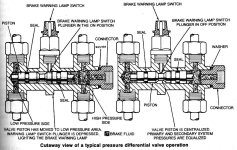I am working on my 67 bronco. It has vacuum boost brakes from a 77 on it dana 44 with factory ford discs, drum rears. standard H distribution block no proportioning valve.
I recently put a new suspension on it did a brake breading and everything was good. When I was working on the truck I notice my master cylinder was leaking from the piston. So I got a new master cylinder from JBG. I did the basic bench bleeding procedure that was recommended, filled with fluid put it on the truck blead the rears no problem, bled the front no fluid? I get very little fluid through my vacuum pump when I bled the fronts. Took it for a ride and don't have any real front brakes until the peddle is about half way down. If I floor the brakes I can get the back to lock up but the front just barely lock.
So any ideas? I have vacuum bled the brakes at least 4 times now gone through over a pint of brake fluid I almost feel like I got a bad master cylinder because the old one worked fine.
I recently put a new suspension on it did a brake breading and everything was good. When I was working on the truck I notice my master cylinder was leaking from the piston. So I got a new master cylinder from JBG. I did the basic bench bleeding procedure that was recommended, filled with fluid put it on the truck blead the rears no problem, bled the front no fluid? I get very little fluid through my vacuum pump when I bled the fronts. Took it for a ride and don't have any real front brakes until the peddle is about half way down. If I floor the brakes I can get the back to lock up but the front just barely lock.
So any ideas? I have vacuum bled the brakes at least 4 times now gone through over a pint of brake fluid I almost feel like I got a bad master cylinder because the old one worked fine.












